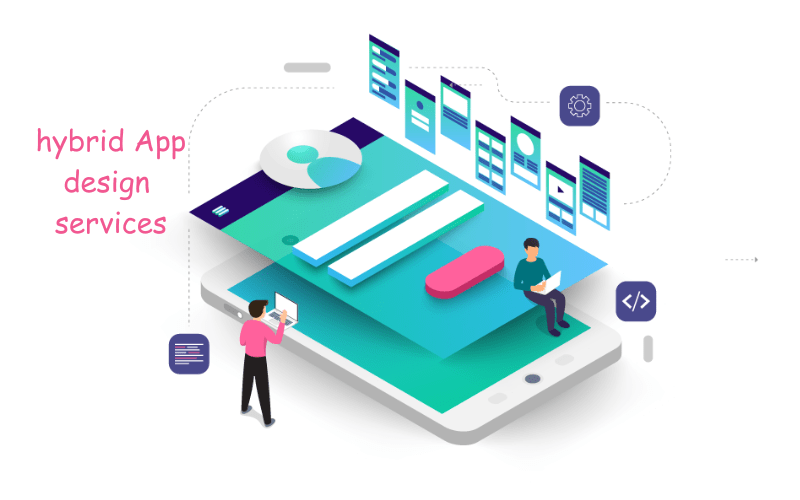Mobile app development has witnessed a paradigm shift with the emergence of hybrid app design. This approach amalgamates the versatility of web technologies with the efficiency of native apps, providing developers with a powerful tool. However navigating the realm of hybrid design comes with its unique set of challenges. In this exploration, we will delve deeper into understanding this design approach and dissect specific challenges. Along with detailed strategies to overcome them.
Want to Know Hybrid App Design
Before we dive into the challenges let’s first establish a foundational understanding of this design approach. Hybrid apps find their roots in a blend of web and native mobile applications. This synergy allows developers to utilize familiar web technologies like HTML, CSS, and JavaScript, encapsulated within a native container. The native container provides a bridge between the web code and the device enabling cross-platform compatibility. This approach not only streamlines development but also allows for a single codebase to be deployed across various platforms.
What are the advantages of hybrid design?
Hybrid apps offer the advantage of running on various platforms, reducing the need for separate development efforts for each operating system.
Since hybrid apps share a common codebase, development costs are significantly lower compared to building separate native apps for each platform.
With a single codebase, developers can expedite the development process, enabling faster time-to-market for the application.
What are some common challenges in hybrid app design?
Here are some common challenges in hybrid design:
-
Performance Bottlenecks
One of the primary challenges in hybrid design is achieving optimal performance. Native apps often outshine hybrids in speed and responsiveness. The inherent differences between web and native technologies can result in performance bottlenecks, leading to a less-than-ideal user experience.
-
User Interface (UI) Consistency
Maintaining a consistent user interface across various platforms poses another challenge. Each operating system has its design guidelines, and creating an interface that seamlessly adapts to iOS, Android, and other platforms requires careful consideration.
-
Limited Access to Native Features
Hybrid apps sometimes face limitations in accessing native device features. While plugins and APIs attempt to bridge the gap, certain advanced functionalities may not be readily available, impacting the app’s overall capabilities.
-
Debugging and Testing
Debugging and testing hybrid apps can be more complex compared to their native counterparts. Identifying and resolving issues across different platforms adds an extra layer of intricacy, demanding thorough testing procedures.
How to overcome these challenges?
Here are effective strategies and solutions on how to overcome hybrid app design guidelines challenges:
-
Performance Optimization Techniques
To address performance bottlenecks, developers can employ various optimization techniques. Caching frequently used data, minimizing HTTP requests, and optimizing images can significantly enhance the app’s speed. Additionally, leveraging hardware acceleration and employing efficient coding practices contribute to a smoother performance.
-
Responsive Design Principles
Achieving UI consistency across platforms requires a commitment to responsive design principles. Developers should adhere to platform-specific design guidelines while incorporating responsive layouts that adapt seamlessly to different screen sizes. Utilizing frameworks like Ionic or Xamarin.Forms can streamline this process.
-
Bridging the Native Gap
To overcome limitations in accessing native features, developers can leverage plugins and third-party APIs. Platforms like Apache Cordova provide a bridge between web and native, enabling hybrid apps to tap into device-specific functionalities. Regularly updating these plugins ensures compatibility with the latest native features.
-
Comprehensive Testing Strategies
To streamline debugging and testing, adopting a comprehensive testing strategy is paramount. Automated testing tools, such as Appium and Selenium, can be instrumental in identifying and rectifying issues across diverse platforms. Real-device testing is also crucial to simulate real-world conditions and ensure optimal performance.
What are the future trends in hybrid app design?
As technology continues to evolve, hybrid design is poised to embrace several trends that will further enhance its capabilities:
The integration of Progressive Web App technologies within hybrid apps is gaining traction. PWAs offer improved performance offline capabilities and enhanced user experiences blurring the lines between web and native applications.
The evolution of hybrid frameworks is paving the way for more advanced tools and features. Frameworks like Flutter and React Native are constantly pushing the boundaries, offering a more native-like experience for hybrid apps.
The infusion of AI into hybrid app development is on the horizon. AI-powered features, such as personalized recommendations and intelligent chatbots, will become integral components of hybrid applications, providing a competitive edge in user engagement.
Conclusion
In conclusion, while hybrid app design presents its share of challenges, the constant evolution of technologies and best practices offers effective solutions. Developers must remain adaptable, embracing optimization techniques, responsive design principles, and the latest frameworks to create hybrid apps that deliver stellar performance and user experiences. As we look to the future, the integration of progressive web technologies, advanced frameworks, and artificial intelligence will undoubtedly shape the landscape of hybrid app development, opening new possibilities for innovation and excellence.
Thanks for visiting Takeneasy



